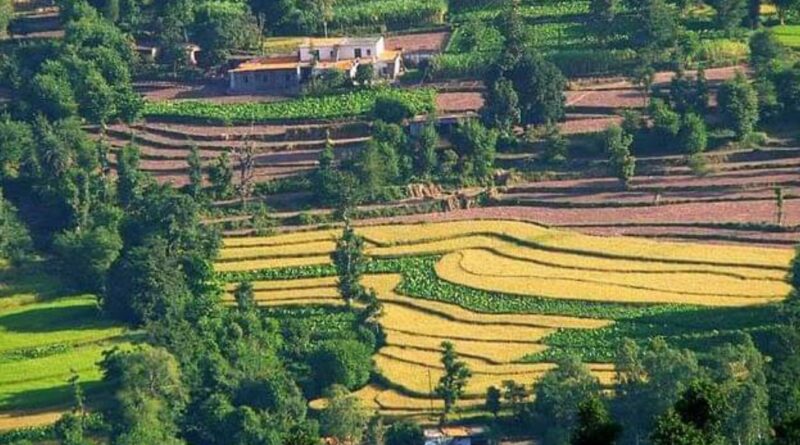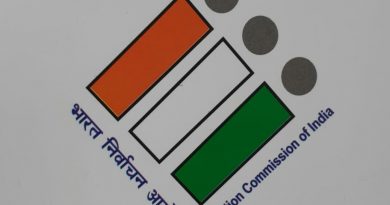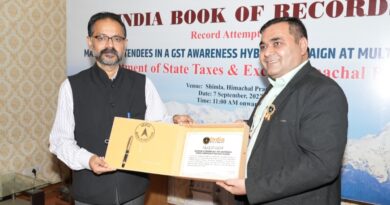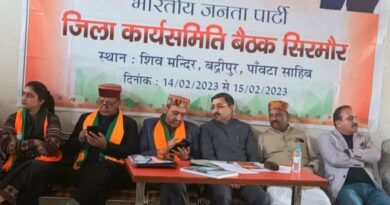Pro-Environment group boycott stakeholders consultantion with WB
Pro-Environment group Himdhara Pariyavarn Samuh boycotted the stakeholders consultantion held by World Bank and state Directorate of Energy recently here blaming the two for undermining People concern by indulging in indiscriminated construction of mega power project wreaking havoc and fatal to Himalayan fragile we ecology.
In a press statement issued by the convenor of Himdhara Pariyavarn Samuh said that on July 5 number of Environment group Including Himdhara was invited to attend the co-opted Stakeholders’ Consultation, but they rejected this invitation. She said that a team of World Bank was in the state for showing its cooperation in making Himachal the first ‘Green State’ of India. She said that though it appears to be alluring on parts of state and WB but its real motive was to take a loan of worth Rs1500 crore rupees from the World Bank. After last two years Environmental diaster which took many lives in Kinnaur like stone shooting and Land slides from WB and State government is trying to show much humane face by holding such events .The WB is trying to hold consultantion for environmental, social and other security system could be strengthened in Himachal’s energy development. Mansi Ashar said that project proposal of the World Bank indicates that state is continuing to be construct large-scale hydroelectric projects which is has only been praised by the WB. She said that environmental and social impacts of so called green energy policy not mentioned in the World Bank documents.The competition to promote hydropower development in the Himalayan regions in the name of clean and renewable energy has been going on for the last two decades. These hydel projects and associated tower lines have been built on a large scale in Himachal and for this thousands of hectares of forest land and trees were razed further exploiting valuable agricultural land has also been acquired. These dams have caused landslides, soil erosion, and massively affected the river’s ecosystem. But the most dangerous thing is that where there is a major flood or landslide and such projects become a blockage in the course of the river, then the intensity of that event increases manifold – as we have seen in the tragedies of Uttarakhand – Kedarnath and then Rishiganga. After the 2013 Uttarakhand tragedy, the Ravi Chopra Committee and Scientific Assessment clarified the role of hydropower and indiscriminate construction in promoting the effects of the Kedarnath flash flood. But we didn’t learn anything from it. The National Disaster Management Authority also clarified its stand in a report on this that these projects are not suitable for high Himalayan regions and other energy options would have to be found. But still World Bank like Institution are celebrating achievement of 11000 MW of state generation of hydel Energy ignoring the fact that too achieved on the cost of invaluable nature and corpse of thousands of lives wreaking frequent accidents in these projects and subsequent diaster caused by anthrogenic reasons. The group shows concern that most of the upcoming schemes in Himachal so far are in climatically vulnerable and ecologically fragile areas. Citing Abhay Shukla Committee, presented in the HP High Court, had suggested blanket ban or stay on new hydroelectric projects in the state until an independent inquiry into the hydroelectric policy was conducted. But the state government completely denied the report.
Non-compliance with environmental regulations and non-implementation of social accountability laws are common after projects are approved. There is no security monitoring of any kind, constantly putting the lives of workers and people in the affected villages at risk. The diminishing space for democratic people’s participation in decision-making processes has worsened the situation over the years. With EIA 2020, MoEF&CC and the government are moving towards eliminating people’s participation. At the same time, the Forest Rights Act and the Land Rights Act, which make NOC mandatory for the affected Gram Sabhas, are also being disregarded and the way is being cleared for the projects by amending the rules of forest transfer.
Due to this, now the tribal communities of Kinnaur and Spiti in the Himalayan region of Kinnaur and Spiti and Lahaul, located in Chandrabhaga, are protesting against the new projects. These are geologically unstable areas that are vulnerable to earthquakes and avalanches. But in the Golden Jubilee Energy Policy 2021 of the government, far from banning the setting up of power projects in these areas, the talk of making the approval mechanism simple and easy has been talked about. The affected communities and environmental organizations have continuously conveyed through memorandums to various government agencies about the absence of accountability and grievance redressal mechanism related to dams in Himachal, and the absence of punitive action, but till date no concrete hearing has taken place.” If the World Bank is really serious about the environmental and social impacts of projects like hydropower, then first of all, what steps have been taken by the government to solve the issues of the people, it should be investigated openly and autonomously.In this investigation, without knowing the side of the public, how the World Bank can get involved in the campaign to make Himachal a green state – it is imperative to raise this question. Eventually the Rampur, Nathpa Jakhari projects were set up with the financial help of institutions like the World Bank and the bank has a moral responsibility as the bank has played the role of promoting massive hydropower projects. It is surprising that a two-and-a-half hour meeting was considered sufficient for consultation with the participants. The government had to openly invite communities affected by energy projects for this meeting to give time to talk if it really intended to consult partners. In this, not only should their side be heard, but in the interest of fairness and environment, effective steps should also be taken by taking changes in energy policy for the future, she added.



